-
Countries
-
Data and Analysis
-
Special Focus
-
Crisis Responses
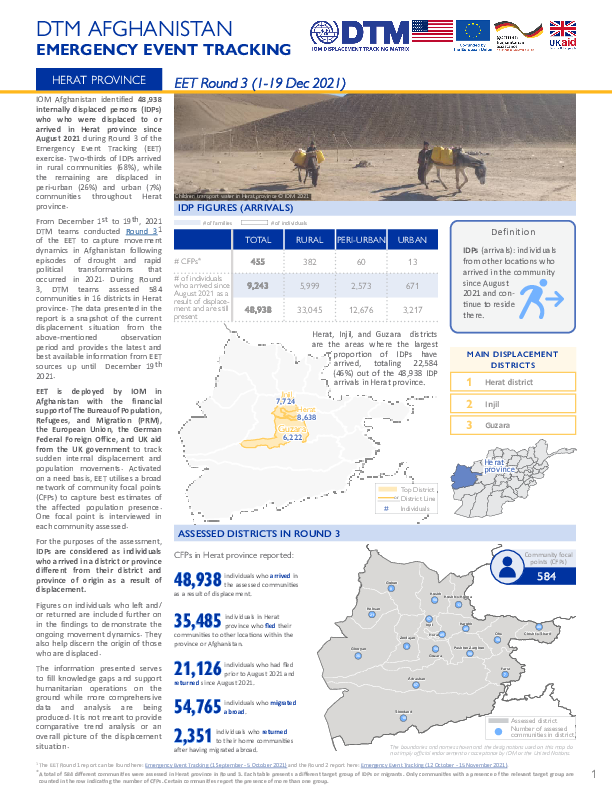
Contact
DTM Afghanistan, DTMKabul@iom.int
Language
English
Location
Afghanistan
Period Covered
Dec 01 2021
Dec 19 2021
Activity
- Event Tracking
IOM Afghanistan identified 48,938 internally displaced persons (IDPs) who were displaced to or arrived in Herat province since August 2021 during Round 3 of the Emergency Event Tracking (EET) exercise. Two-thirds of IDPs arrived in rural communities (68%), while the remaining are displaced in peri-urban (26%) and urban (7%) communities throughout Herat province.
From December 1 to 19, 2021 DTM teams conducted Round 3 of the EET to capture movement dynamics in Afghanistan following episodes of drought and rapid political transformations that occurred in 2021. During Round 3, DTM teams assessed 584 communities in 16 districts in Herat province. The data presented in the report is a snapshot of the current displacement situation from the above-mentioned observation period and provides the latest and best available information from EET sources up until 19 December 2021.

Contact
DTM Burkina Faso, bfinformationunit@iom.int
Language
French
Location
Burkina Faso
Period Covered
Nov 01 2021
Nov 30 2021
Activity
- Event Tracking
- Survey
- Flow Monitoring
Afin de mieux comprendre les tendances des mouvements transhumants et l’impact des fragilités sur les communautés transhumantes, l’OIM, au travers de sa Matrice de suivi des déplacements (DTM), a déployé depuis juin 2019 l’outil de suivi de la transhumance (Transhumance Tracking Tool – TTT) avec le Réseau Bilital Maroobe (RBM) et ses antennes d’organisations d’éleveurs pour faire le suivi des mouvements de transhumants au Burkina Faso.
Le TTT permet de comprendre les dynamiques liées à la transhumance transfrontalière entre le Burkina Faso, le Niger et le Mali. Il combine trois composantes : la cartographie, le comptage et l’alerte.
Le système d’alerte a pour objectif de recenser les évènements liés à l’utilisation des ressources naturelles, aux pratiques agro-pastorales, ainsi qu’aux désastres naturels dans la région transfrontalière des pays du Liptako-Gourma, de comprendre les modes de résolution de conflits existants et d’informer les autorités compétentes afin de réduire les tensions dans les communes d’intervention. Ce système permet de recenser les alertes liées à un évènement conflictuel (alerte évènement) ou à un mouvement massif ou inattendu de bétail (alerte prévention) qui pourrait provoquer un conflit. Ce rapport présente les données de l’outil d’alerte pour le mois de novembre 2021.
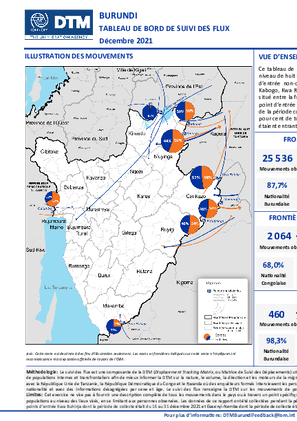
Contact
DTMBurundi@iom.int
Language
French
Location
Burundi
Period Covered
Dec 01 2021
Dec 31 2021
Activity
- Flow Monitoring Survey
- Flow Monitoring
Ce tableau de bord fournit une analyse des tendances de la mobilité des populations observées au niveau de huit points de suivi des flux (Flow Monitoring Points, FMP), six établis sur des points d’entrée non-officiels établis entre la frontière du Burundi et la République Unie de Tanzanie à Kabogo, Kwa Rutuku, Mbundi, Kabuyenge, Mukambati et Kwa Buhinja; un point d’entrée officiel situé entre la frontière du Burundi et de la République Démocratique du Congo à Gatumba et un point d’entrée officiel situé entre la frontière du Burundi et du Rwanda à Gasenyi-Nemba. Au cours de la période considérée, un total de 28 060 mouvements ont été observés à ces points. Environ 51,9 pour cent de tous les mouvements au niveau des trois frontières étaient sortants et 48,1 pour cent étaient entrants.
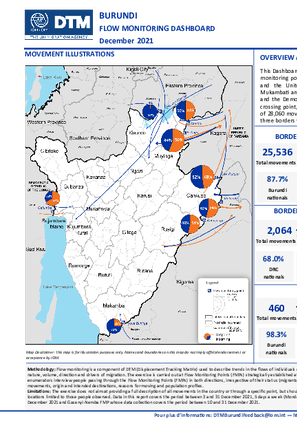
Contact
DTMBurundi@iom.int
Language
English
Location
Burundi
Period Covered
Dec 01 2021
Dec 31 2021
Activity
- Flow Monitoring Survey
- Flow Monitoring
This Dashboard provides an analysis of the trends in population mobility observed at eight flow monitoring points (FMPs), six established at unofficial border crossing points between Burundi and the United Republic of Tanzania border at Kabogo, Kwa Rutuku, Mbundi, Kabuyenge, Mukambati and Kwa Buhinja; one established at official border crossing point, between Burundi
and the Democratic Republic of the Congo at Gatumba and one established at official border crossing point, between Burundi and Rwanda at Gasenyi-Nemba. Over the reporting period, a total of 28,060 movements were observed at these points. About 51.9 per cent of all movements at the three borders were outgoing and 48.1 per cent were incoming.
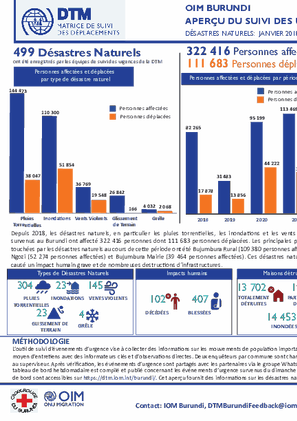
Contact
DTM Burundi, DTMBurundi@iom.int
Language
French
Location
Burundi
Period Covered
Jan 01 2018
Dec 31 2021
Activity
- Event Tracking
- Mobility Tracking
Depuis 2018, les désastres naturels, en particulier les pluies torrentielles, les inondations et les vents violents survenus au Burundi ont affecté 322 416 personnes dont 111 683 personnes déplacées. Les principales provinces touchées par les désastres naturels au cours de cette période ont été Bujumbura Rural (109 380 personnes affectées), Ngozi (52 274 personnes affectées) et Bujumbura Mairie (39 464 personnes affectées). Ces désastres naturels ont causé un impact humain grave et de nombreuses destructions d’infrastructures.
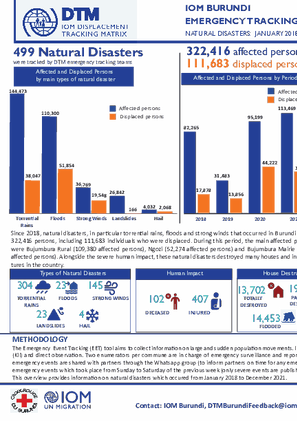
Contact
DTM Burundi, DTMBurundi@iom.int
Language
English
Location
Burundi
Period Covered
Jan 01 2018
Dec 31 2021
Activity
- Event Tracking
- Mobility Tracking
Since 2018, natural disasters, in particular torrential rains, floods and strong winds that occurred in Burundi affected
322,416 persons, including 111,683 individuals who were displaced. During this period, the main affected provinces
were Bujumbura Rural (109,380 affected persons), Ngozi (52,274 affected persons) and Bujumbura Mairie (39,464
affected persons). Alongside the severe human impact, these natural disasters destroyed many houses and infrastructures
in the country.
This Middle East and North Africa (MENA) report summarizes mobility restrictions at airports, land, and blue border crossing points resulting from the mitigation measures implemented in response to the COVID-19 pandemic.
Contact
DTM Yemen, iomyemendtm@iom.int
Location
Yemen
Activity
- Event Tracking
- Mobility Tracking
Period Covered
Jan 23 2022 -Jan 29 2022
From 01 January 2022 to 29 January 2022, IOM Yemen DTM estimates that 2,190 households (HH) (13,140 Individuals) have experienced displacement at least once.
Since the beginning of 2022, DTM also identified 4 displaced households who left their locations of displacement and either moved back to their place of origin or another location.
Between 23 and 29 January 2022, IOM Yemen DTM tracked 462 households (2,772 individuals) displaced at least once. The top three governorates and districts where people moved into/within are:
• Shabwah (170 HH) – Ataq (122 HH), Bayhan (30 HH), Ayn (18 HH) districts. Most displacements in the governorate were internal.
• Al Hodeidah (141 HH) – Hays (114 HH), Al Khukhah (27 HH) districts. Most displacements in the governorate originated from Al Hodeidah and Taiz.
• Marib (76 HH) – Marib City (49 HH), Marib (27 HH) districts. Most displacements in the governorate originated from Marib and Shabwah.
Most displacements resulted from the increased conflict in the following governorates and districts.
• Shabwah (159 HH) – Ayn (159 HH) district.
• Al Hodeidah (99 HH) – Hays (85 HH), Al Hawak (4 HH), Al Khukhah (3 HH) districts.
• Taiz (93 HH) – Maqbanah (61 HH), Jabal Habashi (18 HH), Sabir Al Mawadim (4 HH) districts.
Population Groups
Survey Methodology
Unit of Analysis Or Observation
Type of Survey or Assessment
Keywords
Geographical Scope
Administrative boundaries with available data
The current dataset covers the following administrative boundaries

Contact
DTM Yemen, iomyemendtm@iom.int
Language
English
Location
Yemen
Period Covered
Jan 23 2022
Jan 29 2022
Activity
- Rapid Emergency Registration
- Mobility Tracking
IOM Yemen DTM’s Rapid Displacement Tracking (RDT) tool collects data on estimated numbers of households forced to flee on a daily basis from their locations of origin or displacement, allowing for regular reporting of new displacements in terms of estimated numbers, geography, and needs. It also tracks Returnees who returned to their location of origin.
From 01 January 2022 to 29 January 2022, IOM Yemen DTM estimates that 2,190 households (HH) (13,140 Individuals) have experienced displacement at least once.
Since the beginning of 2022, DTM also identified 4 displaced households who left their locations of displacement and either moved back to their place of origin or another location.
Between 23 and 29 January 2022, IOM Yemen DTM tracked 462 households (2,772 individuals) displaced at least once. The top three governorates and districts where people moved into/within are:
- Shabwah (170 HH) – Ataq (122 HH), Bayhan (30 HH), Ayn (18 HH) districts. Most displacements in the governorate were internal.
- Al Hodeidah (141 HH) – Hays (114 HH), Al Khukhah (27 HH) districts. Most displacements in the governorate originated from Al Hodeidah and Taiz.
- Marib (76 HH) – Marib City (49 HH), Marib (27 HH) districts. Most displacements in the governorate originated from Marib and Shabwah.
Most displacements resulted from the increased conflict in the following governorates and districts.
- Shabwah (159 HH) – Ayn (159 HH) district.
- Al Hodeidah (99 HH) – Hays (85 HH), Al Hawak (4 HH), Al Khukhah (3 HH) districts.
- Taiz (93 HH) – Maqbanah (61 HH), Jabal Habashi (18 HH), Sabir Al Mawadim (4 HH) districts.
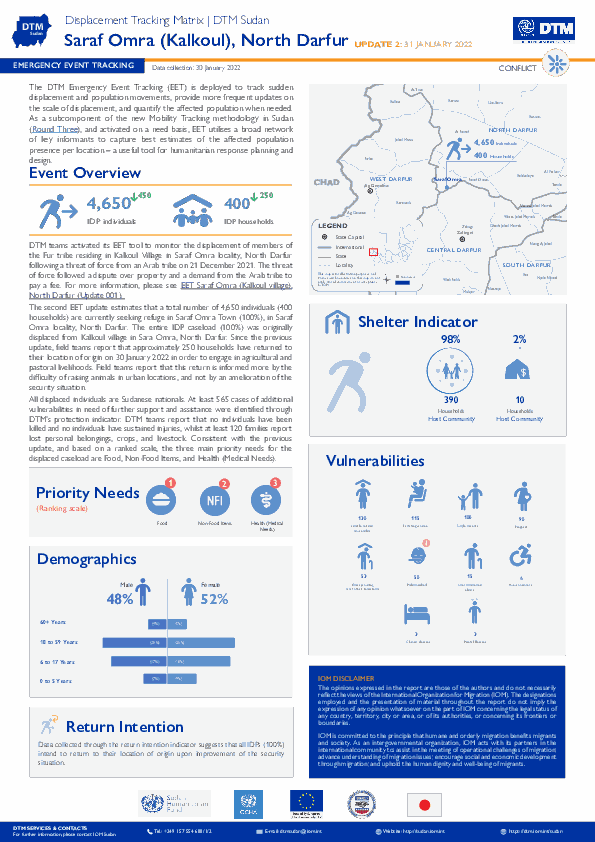
Contact
DTM Sudan; dtmsudan@iom.int
Language
English
Location
Sudan
Snapshot Date
Jan 30 2022
Activity
- Event Tracking
- Mobility Tracking
The DTM Emergency Event Tracking (EET) is deployed to track sudden displacement and population movements, provide more frequent updates on the scale of displacement, and quantify the affected population when needed. As a subcomponent of the new Mobility Tracking methodology in Sudan (Round Three), and activated on a need basis, EET utilises a broad network of key informants to capture best estimates of the affected population presence per location – a useful tool for humanitarian response planning and design.
